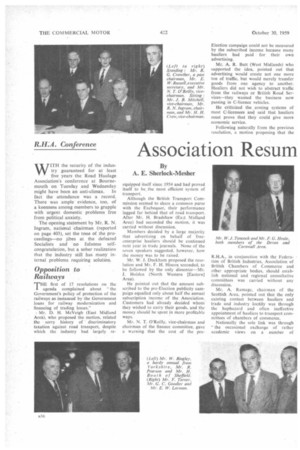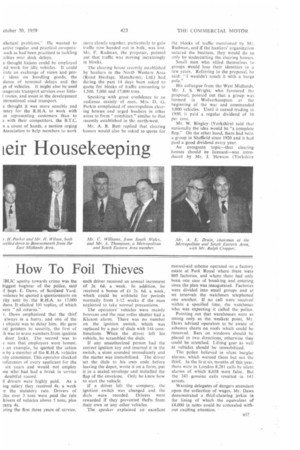outing Elusive Noises
Page 69

Page 70

Page 71

If you've noticed an error in this article please click here to report it so we can fix it.
effective means for tracing the ource of extraneous noises in vehicle s and bodywork is provided by the I Locator manufactured by Qualitec -leers), Ltd.. I I illbottom Road, Sands, Wycombe. Bucks. The apparatus ,ts of two matched microphones d on 1-ft.-Iong flexible arms attached Lgnetic bases. The microphones are cted by long leads to an amplifier incorporates a transistor and operAI a small dry battery. A control omprising a two-way switch for the phones, a volume control and an switch is embodied in the amplifier, utput from which is fed to heads.
Teration the microphones are placed Ise as possible to the source of the eted noise. When this noise is eel by driving the vehicle or by other ; the two-way switch is flicked alter' from one microphone to the and whichever microphone is nearest seat of the trouble will pick up the st signal. The microphone receiving weakest response is then moved ds the other until an equal signal is ed on both. When this stage is eel the microphones are equi-distant the noise source which can then be Anted.
o the Sound Locator can be used ally as a stethoscope to trace the on of engine noises, for example. It pplied in a wooden cabinet for s. by post.
Bender
addition to the range of Staffa tube ending appliances manufactured • by iberlain Industries, Ltd., Leylon, on, E.I0, is a mandrel-type handted model for bending tubes with le diameters from in. to I in.
e machine can be supplied for bench ting or with a special stand to allow forming of intricate shapes. It is ole of bending steel tubes to radii to twice, or in certain cases 1+ the tube diameter.
ver Amber
a driving aid in fog, Holt Products, .td., New Addington, Surrey, offer a means of converting normal Staffa hand-operated tube bender cope with tubes having outside diaers from in. to 1 in. It can be bench°tented or fitted to a special stand. headlamps to give amber illumination. This is a translucent substance, known as Fog cote, which is brushed on to the headlamp lens to form a semi-permanent amber coating. It is claimed that the use of Fog-cote does not lessen the headlamp range or intensity to an appreciable extent. The lacquer is supplied with a brush and costs 3s. 6d.
An emergency silencer repair kit costing 3s. 104, is another addition to the Holt range. The Gun Gum Silencer Bandage Kit, as it is known, consists of an impregnated woven strip 2 ft. long and 2 in. wide and a length of metal foil. When dealing with a large hole in the silencer the foil is placed over the aperture and the woven strip, having been soaked in methylated spirits or water, is placed around it and wired into position. The repair becomes " cured " by the heat of the exhaust system.
Sealed-beam Headlamps
REATER aiming accuracy than is k-I possible with pre-focus bulbs is offered by a sealed-beam headlamp unit manufactured by Joseph I.ucas. Ltd.. Great King Street, Birmingham, 19. In this lamp the bulb and the whole headlamp unit become one with the double transverse filament and bulb shield sealed to the back of the lamp so that the whole unit becomes, in effect, a very large bulb.
Aiming of the lamp is adjusted by the disposition of glass studs moulded on to the front of the lens. In addition to greater accuracy it is claimed that with the sealed-beam unit the quality of light will not deteriorate as quickly as that from small bulbs and that the light available from a filament of given wattage will be dispersed more effectively. Initially, the lamp will be available in a 7-in.diameter version only for fitting as original equipment.
Hose Clamp
AVAILABLE from Matchless dTh Machines, Ltd., London, W.1, are 0-shaped clamps manufactured by Hans Oetiker, Hergen, Switzerland. The clamp consists of a wide circular band with two or three lugs depending on its size. It is placed around the hose and the lugs are crimped together with special pincers. To remove the clip a lug is snipped off with the same tool.
Piston Heater 1.'0 assist in removing gudgeon pins I from pistons, Eltron (London), Ltd., Strathmore Road, Croydon. Surrey, offer an electrical piston heater. It consists
of a handle and control unit to which is attached a tubular element formed into a spiral. The heater operates from the main supply at a loading of 450 watts. In operation the spiral element is placed around the piston for a few minutes expanding it to release the gudgeon pin. The unit costs £4 15s.
Tall Door A NI overhead folding door produced
by Westland Engineers, Ltd., Yeovil, Somerset, is designed for fitting to high openings in garages and industrial buildings. The door, which is known as the Wel fold, consists of two panels hinged together horizontally across the centre line. Both panels are counterbalanced and fold together when the door is open, reducing the overall projection both inside and outside the building.
Installation of the Welfold places no load on the door lintel and neither sidewall nor roof fixings are required. Movement of the door is controlled by vertical steel tracks and by pivoted arms attached to the top panel and the door jambs,
Mobile Charger A BATTERY charger made by the
Wipac Group, Bletchley, Bucks, can be attached permanently to a vehicle. It costs £2 15s.. and is similar in appearance and dimensions to a standard ignition coil. It is known as the Chargemobile and will provide a charging rate of I to 11 amp. when connected to a Mains supply of 220 v. to 250 v.
The battery charger works automatically and requires no regulation. It is oil-filled for durability and, by means of a two-pin reversible plug which incorporates a fuse, can be employed for 6-v. or 12-v. systems.
Omnibus Edition FOR the first time the Modern Car Easy Guide series of six separate booklets is now available in one stiffcovered omnibus edition. The 318-page work is published by Temple Press Limited, Bowling Green Lane, London, E.C.1, and covers in detail the component parts of the modern car with a lucid explanatory text and numerous diagrams. It is good value at 10s. 6d.
Election campaign could not be measured by the subscribed income because many hauliers had paid for their own advertising.
Mr. A. R. Butt (West Midlands) who supported the idea, pointed out that advertising would create not one more ton of traffic, but would merely transfer goods from one agency to another. Hauliers did not wish to abstract traffic from the railways or British Road Services—they wanted the business now passing in C-licence vehicles.
He criticized the costing systems of most C-licensees and said that hauliers must prove that they could give more economic service.
Following naturally from the previous resolution, a motion proposing that the ithetical problems," He wanted to ictive regular and practical co-operasuch as had been practised in tackling :ulties over dock delays.
e thought liaison could be employed nd work for idle vehicles. It could hate an exchange of views and pro: ideas on handling goods, the dance of terminal delays and the gn of vehicles. It might also be used iaugurate transport services over little1 routes, and assist in the development aternational road transport.
e thought it was more sensible and ssary for the R.H.A. to work with es representing customers than to e with their competitors, the B.T.C.
e a count of hands, a motion urging Association to help members to work more closely together, particularly to gain traffic now handed out in bulk, was lost, Mr. F. Rudman, the proposer, pointed out that traffic was moving increasingly in blocks.
The clearing house recently established by hauliers in the North Western Area (Road Haulage. Manchester. Ltd.) had during the past 14 days been asked to quote for blocks of traffic amounting to 1,500, 5,000 and 17,000 tons.
Speaking with great cmfidence to an audience mainly of men, Mrs. D. G. Parkin complained of unscrupulous clearing houses and urged hauliers in other areas to form " combines " similar to that recently established in the north-west.
Mr. A. R. Butt replied that clearing houses would also be asked to quote for the blocks of traffic mentioned by Mr. Rudman, and if the hauliers' organization secured the business, they would do so only by undercutting the clearing houses.
Small men who allied themselves to groups would lose their identities in a few years. Referring to the proposal, he said: "I wouldn't touch it with a barge pole."
His colleague from the West Midlands, Mr. J. S. Wright, who favoured the proposal, pointed out that a group was formed in Wolverhampton at the beginning of the war and commanded 3.000 vehicles. Until it ceased trading in 1950, it paid a regular dividend of 10 per cent.
Mr. W. Bingley (Yorkshire) said that nationally the idea would be "a complete flop." On the other hand, there had been a group in Sheffield since 1920 and it had paid a good dividend every year, An evergreen topic—that clearing houses should be licensed—was introduced by Mr. J. Hewson (Yorkshire




















































































































